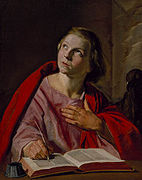St Matthew (Hals)
| St. Matthew | |
|---|---|
 St. Matthew, c.1625 Oil on canvas, 70 x 55 cm | |
| Artist | Frans Hals |
| Year | 1625 |
| Catalogue | Seymour Slive, Catalog 1974: #44 |
| Medium | Oil on canvas |
| Dimensions | 70 cm × 55 cm (28 in × 22 in) |
| Location | Odesa Museum of Western and Eastern Art, Odesa |
| Accession | 180 |
St. Matthew is an oil-on-canvas painting by the
Dutch Golden Age painter Frans Hals, painted in 1625 and now in the Odesa Museum of Western and Eastern Art, Odesa
.
Painting
The painting shows
tronies were discovered languishing in the storerooms of the Odesa Museum of Western and Eastern Art in 1958 by art historian Irina Linnik. At the time they were considered to be by unknown 19th-century painters, but Linnik recognized them as the work of a 17th-century master and eventually traced their history back to the 17th century, identifying them as two of four lost paintings by Hals of the evangelists, namely Luke and Matthew.[2][3] After her work was published in 1959, the two paintings were included in the 1962 Frans Hals exhibition in the Frans Hals Museum
. The international attention helped to spur art detectives and eventually the other two of John and Mark were also rediscovered.
In his 1989 catalog of the international Frans Hals exhibition, Slive included a photo of Hals'
Two singing boys with a lute and a music book to show that his theme of a main subject with a secondary witness was common to many of Hals' paintings of the 1620s and the models as secondary witness in these two paintings were clearly cousins.[4]
Two singing boys and Matthew:
-
Two singing boys
-
St. Matthew
The four evangelists by Hals:
-
St. Luke
-
St. Matthew
-
St. Mark
-
St. John
See also
References
- RKD
- ^ Article from the Pushkin Museum of Art, published in Courant 11, Codart, 2006
- ^ Seymour Slive and C.A. van Hees, Frans Hals Exhibition catalog, 1962, #77 & #78, St. Luke & St. Matthew, Addendum
- ISBN 3791310321





